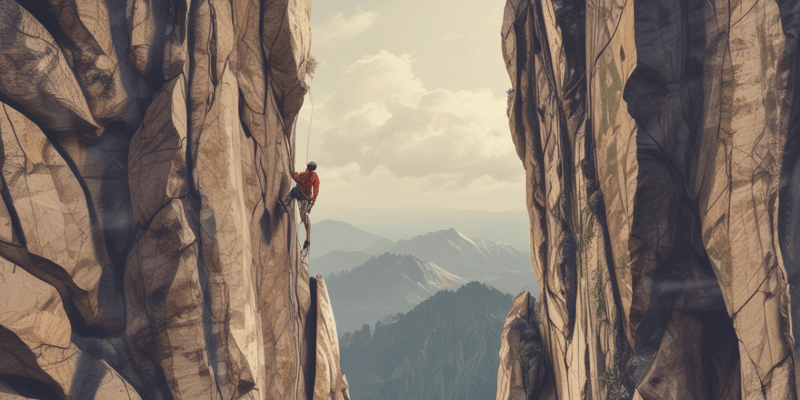Podcast
Questions and Answers
What is the primary reason for mountaineering?
What is the primary reason for mountaineering?
What did natural philosophers in the 18th century do in the Alps of Europe?
What did natural philosophers in the 18th century do in the Alps of Europe?
In what century did the truly international character of mountaineering begin to reveal itself?
In what century did the truly international character of mountaineering begin to reveal itself?
What is another name for mountain climbing?
What is another name for mountain climbing?
Signup and view all the answers
What is a mountaineer?
What is a mountaineer?
Signup and view all the answers
What was the area around Chamonix, France, known for?
What was the area around Chamonix, France, known for?
Signup and view all the answers
What is the primary difference between hiking and trekking?
What is the primary difference between hiking and trekking?
Signup and view all the answers
Who is considered the father of modern camping?
Who is considered the father of modern camping?
Signup and view all the answers
What is the main purpose of the 'Leave no trace' principle?
What is the main purpose of the 'Leave no trace' principle?
Signup and view all the answers
What is the main characteristic of Ultra-Light backpacking?
What is the main characteristic of Ultra-Light backpacking?
Signup and view all the answers
What type of hazard is related to a climber's poor judgment or lack of skills?
What type of hazard is related to a climber's poor judgment or lack of skills?
Signup and view all the answers
What is essential to improve before going on a hike or trek?
What is essential to improve before going on a hike or trek?
Signup and view all the answers
What type of tent is characterized by a round framework that deploys automatically?
What type of tent is characterized by a round framework that deploys automatically?
Signup and view all the answers
What type of camping involves hiking a distance with all your supplies in your backpack?
What type of camping involves hiking a distance with all your supplies in your backpack?
Signup and view all the answers
What is an essential tool for mountaineering?
What is an essential tool for mountaineering?
Signup and view all the answers
What is a benefit of mountaineering?
What is a benefit of mountaineering?
Signup and view all the answers
What type of sleeping bag has a part that covers the head and neck with an opening for the face?
What type of sleeping bag has a part that covers the head and neck with an opening for the face?
Signup and view all the answers
What type of camp site offers electric hookups for RVs, water, and amenities like flush toilets, dumping stations, and sometimes showers?
What type of camp site offers electric hookups for RVs, water, and amenities like flush toilets, dumping stations, and sometimes showers?
Signup and view all the answers
What is the primary advantage of hiking boots over hiking shoes?
What is the primary advantage of hiking boots over hiking shoes?
Signup and view all the answers
What is the main purpose of a backpack in terms of its design?
What is the main purpose of a backpack in terms of its design?
Signup and view all the answers
What is the primary benefit of using trekking poles, especially for those with certain health issues?
What is the primary benefit of using trekking poles, especially for those with certain health issues?
Signup and view all the answers
What is one of the health-related benefits of hiking, according to the text?
What is one of the health-related benefits of hiking, according to the text?
Signup and view all the answers
What is the first safety guideline mentioned in the text for hiking and trekking?
What is the first safety guideline mentioned in the text for hiking and trekking?
Signup and view all the answers
What is camping, according to the text?
What is camping, according to the text?
Signup and view all the answers
What type of camping site does not allow RVs or trailers?
What type of camping site does not allow RVs or trailers?
Signup and view all the answers
What is the term used to describe the sport of navigating through the woods with a map and compass?
What is the term used to describe the sport of navigating through the woods with a map and compass?
Signup and view all the answers
What is used to mark control locations on an orienteering map?
What is used to mark control locations on an orienteering map?
Signup and view all the answers
In an orienteering competition, what is each participant competing for?
In an orienteering competition, what is each participant competing for?
Signup and view all the answers
What does the brown color on an orienteering map represent?
What does the brown color on an orienteering map represent?
Signup and view all the answers
Study Notes
Mountaineering
- Mountaineering, also known as mountain climbing, is a sport that involves ascending mountains mainly for pleasure.
- A mountaineer is a person who climbs mountains for sport, and it can be anyone who lives in a high country.
History of Mountaineering
- In ancient times, people climbed mountains for reasons such as erecting altars, determining whether spirits still haunted forbidden heights, and making meteorological or geological observations.
- In the 18th century, natural philosophers began making field trips into the Alps to make scientific observations.
- In the 20th century, mountaineering became a truly international sport.
Types of Camping
- Car Camping: campsites are accessed by car or RV, amenities vary by campground, and campers sleep in trailers.
- Backpacking: involves hiking a distance with all supplies in a backpack, gears should be compact and light.
- Ultra-Light: a form of backpacking that emphasizes lightweight gear and only packs essentials.
- Canoe Camping: a combination of canoeing and camping, carrying enough supplies to travel several days via canoe or boat.
Types of Tents
- Pop-up Tent: round tent with a framework that deploys automatically.
- One-person Tent: small, low-roofed tent with enough room to accommodate one person.
- Dome Tent: semicircular tent that can be moved without being taken down.
Types of Sleeping Bags
- Mummy: has a part that covers the head and neck with an opening for the face.
- Rectangular: spacious enough to give the body room to move.
Types of Camp Sites
- Full Service: offers electric hookups for RVs, water, and amenities like flush toilets, dumping stations, and showers.
Phases in Mountaineering
- Regular Terrain: initial phase, involving normal terrain.
- Rocky Area: second phase, involving rocky terrain.
- Ice or Snow Lope: third phase, involving ice or snow.
Essentials and Tools of Mountaineering
- Footwear: crampons, harness, rope, belay device, and ice axe.
- Clothing: layers, hats, gloves, and goggles.
- Food and Water: nutrition, hydration, and cooking equipment.
- Shelter: tents, sleeping bags, and camping gear.
- Navigation: maps, compasses, and GPS devices.
- First Aid: medical kit, emergency response, and rescue equipment.
Health Benefits of Mountaineering
- Improves physical and cardiovascular fitness.
- Improves personal confidence.
- Reduces fats.
- Encourages teamwork.
Hazards in Mountaineering
- Objective hazards: relate to the environment, including inclement weather, dangerous terrain, and poor equipment.
- Subjective hazards: relate to a climber's poor judgment, poor planning, lack of skills, or inadequate conditioning.
Leave No Trace Principles
- Plan ahead and prepare.
- Travel and camp on durable surfaces.
- Dispose of waste properly.
- Leave what you find.
- Minimize campfire.
- Respect wildlife.
- Be considerate of others.
Hiking and Trekking
- Hiking: done on man-made roads or well-made trails, shorter in distance, and takes one or two days to cover.
- Trekking: more vigorous, done over a variety of terrain, and takes more time and days to climb.
Essential Equipment for Hiking and Trekking
- Footwear: hiking shoes, boots, and backpacking boots.
- Backpack: designed to give wearer support, protection, and better weight distribution.
- Trekking Poles: essential for those with knee problems, with a dual function as a tent pole.
Health Benefits of Hiking and Trekking
- Lower stress levels.
- Improved mood.
- Enhanced mental wellbeing.
- Reduced risk for heart disease.
- Improved control over healthy weight.
- Improved balance.
- Improved stamina.
Trekking Safety Guidelines
- Hike with a group and never alone.
- Follow instructions from guide facilitators or leaders.
- Keep in mind and heart the Leave No Trace Seven Principles.
- Ensure the safety of self and others.
Camping
- It is an outdoor activity involving overnight stays away from a shelter such as a tent or recreational vehicle.
- Types of campsites: tent only, primitive, and full service.
Gear List Essentials for Camping
- First Aid Kit.
- Sunscreen.
- Backpack.
- Food and Water.
- Bug Repellent.
- Sleeping bag.
- Tent.
- Flashlight.
- Camp Stove.
- Matches and Clothes.
- Foot Gear and Rain Gear.
Health Benefits of Camping
- Fresh air.
- Socialization.
- Less stress.
- Exercise.
- Good food.
- Meditation.
Orienteering
- It is the sport of navigating through the woods with a map and compass.
- Control locations are marked on your map, and your goal is to find them in the woods.
History of Orienteering
- It started in the late 19th century in Sweden.
- The actual term “orienteering” was first used in 1886 and meant the crossing of unknown land with the aid of a map and a compass.
- The first orienteering competition open to the public was held in Norway in 1897.
Equipment for Orienteering
- Compass.
- Finger Stick.
- Map.
- Control Description Sheet.
General Information about Orienteering
- You can orienteer solo or in small groups.
- You are competing for the fastest time.
- Map Key: blue for water, yellow for open areas, green for ground vegetation, black for rock features or man-made objects, white for forest, and brown for contour lines.
Studying That Suits You
Use AI to generate personalized quizzes and flashcards to suit your learning preferences.
Description
Test your knowledge of mountaineering, also known as mountain climbing, including its definition, history, and who can participate in this sport. Learn about the basics of mountaineering and its evolution over time.





